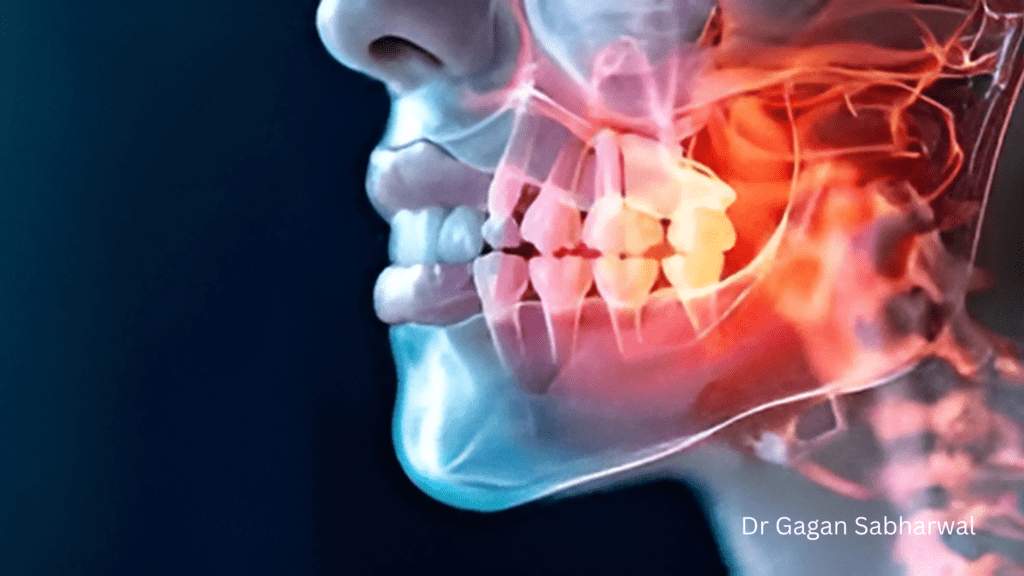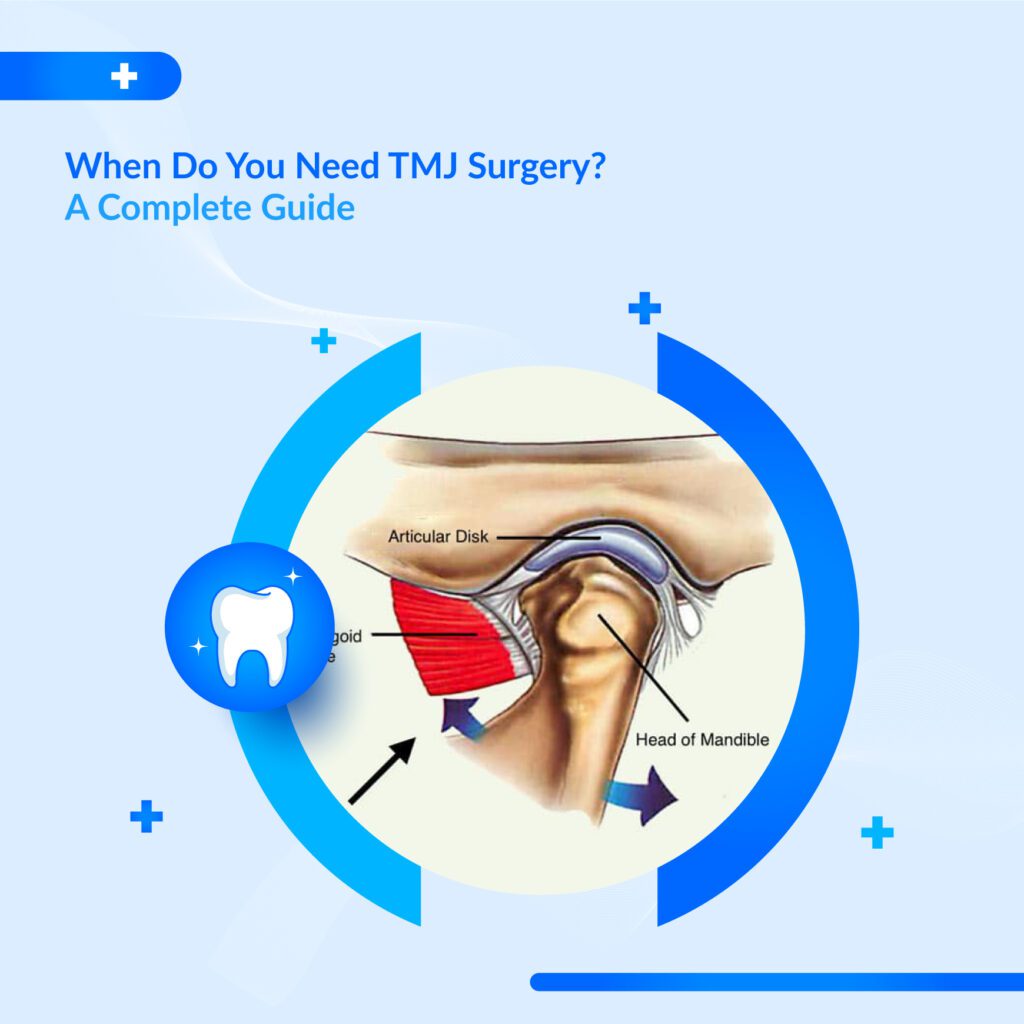Jaw pain, clicking, or trouble opening your mouth disturbs daily life. You’re not alone, these are signs of a TMJ disorder.
Many start with at-home remedies. But when might TMJ surgery be the right path? Here’s a clear, step-by-step guide.
What Is TMJ Disorder?
- The temporomandibular joint (TMJ) joins your skull and jaw.
- When stressed, it causes:
- Jaw joint pain
- Clicking or popping sounds
- Difficulty opening or closing
- Ear pain or headaches
- Jaw joint pain
- Around 10–15% of adults worldwide experience TMJ-related symptoms. Temporomandibular Disorders: Current Concepts and Controversies in Diagnosis and Management – PMC.
Regular Causes of TMJ Problems
TMJ disorders can come from:
- Teeth grinding or jaw clenching
- Injury to the jaw or face
- Arthritis of the jaw joint
- High stress levels and muscle tension
- Misaligned bite or dental issues
These factors strain the joint and aggravate discomfort.

Non-Surgical Treatments First
Before surgery, doctors try easier, safer treatments:
- Avoid chewing gum or hard foods
- Take pain relievers and anti-inflammatories
- Use night splints or mouthguards
- Practice jaw exercises or physiotherapy
- Manage stress with relaxation techniques
If pain continues after several months, surgery may be considered.
When Is TMJ Surgery Needed?
You might need surgical intervention when:
- Severe jaw pain persists despite treatment
- Your jaw locks open or closed
- Imaging shows serious joint damage or disc displacement
- Tumors, cysts, or bone deformities exist in the joint
- Advanced arthritis impairs normal function
Such situations call for expert assessment.
Types of TMJ Surgery
There are several surgical options:
- Arthrocentesis
- Flushes joint to lessen inflammation
- Minimally invasive
- Flushes joint to lessen inflammation
- Arthroscopy
- Employs tiny tools through small incision
- Treats structural issues with low recovery time
- Employs tiny tools through small incision
- Open-Joint Surgery
- Corrects severe joint damage
- Detaches abnormal tissue or aligns bones
- Corrects severe joint damage
- Joint Replacement
- Used only when damage is irrevocable
- Artificial joints replace normal function
- Used only when damage is irrevocable
Risks and Recovery After TMJ Surgery
Every surgery carries possibilities:
- Infection or swelling
- Nerve damage (rare)
- Stiff jaw during initial recovery
Recovery times change:
- Arthrocentesis: a few days
- Arthroscopy: a week or two
- Open surgery: several weeks with rehabilitation
Success rates depend on surgeon experience and post-surgical care.
Case Study: Real TMJ Success in Dubai
A patient in Dubai suffered chronic jaw locking even after therapy.
Diagnostic imaging showed disc displacement.
After arthroscopic treatment by Dr Gagan Sabharwal , she regained absolute jaw movement.
Today, she eats, laughs, and lives painfree.

Why You Should Choose Expert TMJ Care in Dubai
Success rates ameliorate with specialized care.
Dr. Gagan Sabharwal brings:
- Profound expertise in TMJ management
- Latest imaging and minimally invasive tools
- A caring, patient-first approach for fast, safe recovery
He stands out among medical providers in the UAE for TMJ disorder and surgical precision.
Final Thoughts: Listen to Your Jaw
If jaw pain persists despite non-surgical care, pay attention to it.
TMJ surgery may be the solace you need when chosen wisely and timely.
Early diagnosis, traditional care first, and surgery when necessary deliver the best results.
Ready to Learn More or Book a Consultation?
- Schedule a TMJ evaluation with us
- Get a custom-made treatment plan
- Find long-lasting relief from jaw joint pain with expert care in Dubai
Contact Us Today and reclaim your comfort and confidence.
FAQs About TMJ Surgery
TMJ disorder refers to dysfunction or pain in the temporomandibular joint, which connects your jawbone to your skull. It can be caused by teeth grinding, jaw injury, arthritis, stress-related clenching, or misaligned teeth. Common symptoms include jaw joint pain, stiffness, and clicking sounds while opening or closing the mouth.
TMJ surgery is usually recommended when conservative treatments such as medication, physical therapy, or splints do not relieve pain or restore jaw movement. You may need TMJ surgery if you experience chronic jaw joint pain, locking of the jaw, or severe structural damage visible on imaging scans.
TMJ surgery options include:
– Arthrocentesis: A minimally invasive procedure to flush out inflammation.
– Arthroscopy: Uses a small camera to remove scar tissue or realign the joint.
– Open-joint surgery: For complex cases where there’s bone or tissue damage.
Your oral and maxillofacial surgeon will recommend the best type based on the severity of your TMJ disorder.
Recovery time depends on the type of TMJ surgery performed.
– Arthrocentesis or arthroscopy: Recovery may take 1–2 weeks.
– Open-joint surgery: Full recovery can take 4–6 weeks or longer.
Following your surgeon’s post-operative care plan helps reduce swelling, improve mobility, and prevent recurrence of jaw joint pain.
Yes. Most TMJ disorders improve with non-surgical treatments like bite correction, stress management, pain-relief medication, and physiotherapy. Surgery is only considered when these methods fail to relieve chronic jaw joint pain or restore proper jaw function.



